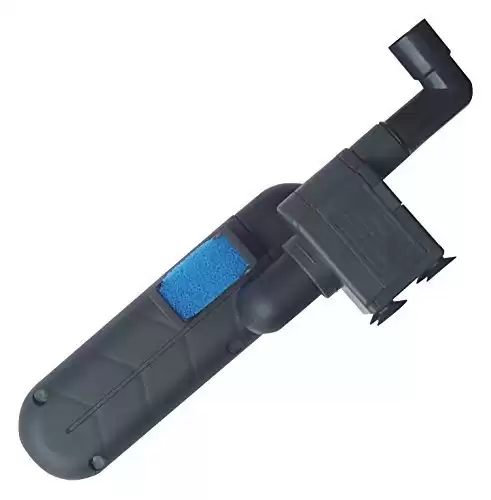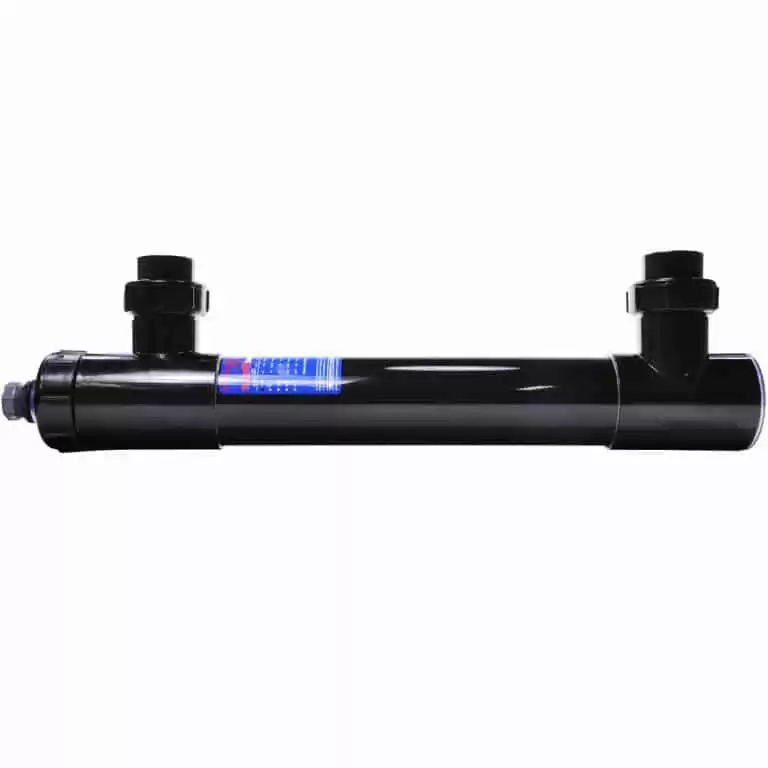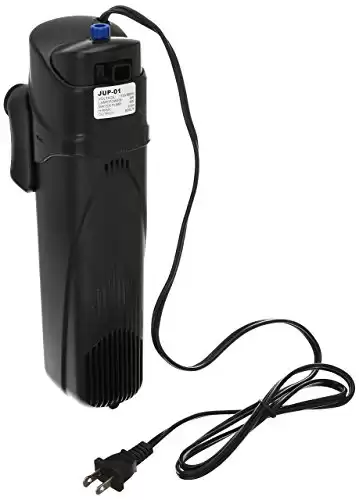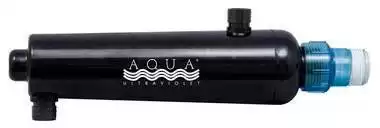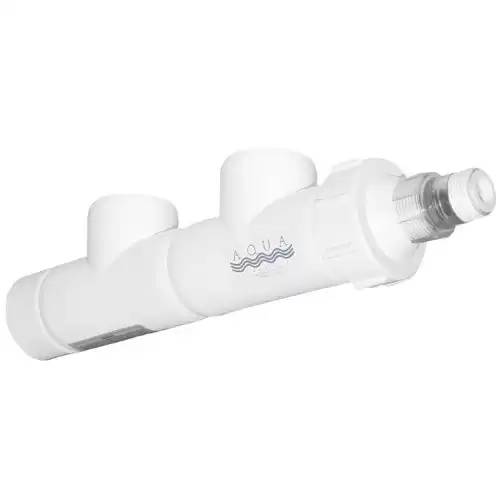UV sterilizers are used by some hobbyists to kill bacteria and pathogens in the tank without harming the fish. But do you really need a UV sterilizer for your freshwater aquarium?
Read on to discover everything you need to know about UV sterilizers, how they work, what they do, and whether or not you actually need one.
|
Primary Rating:
4.8
|
Primary Rating:
4.0
|
Primary Rating:
4.3
|
What is a UV sterilizer for a fish tank?
A UV sterilizer is a small electronic device you place inside your fish tank that contains a UV light tube or bulb that’s designed to kill bacteria, single-celled organisms, and algae that pass through the light.
What do aquarium UV sterilizers do?
The UV light changes and damages the organism’s DNA, effectively killing or sterilizing it so it can’t reproduce. Most bacteria don’t live longer than a few hours, so the loss of reproductive ability is usually enough to wipe out any pathogen or algae outbreaks.
Chemical antibacterial and algae-killing treatments can be dangerous to some fish and corals. However, UV light can be used safely without harming your fish or invertebrates. That said, it’s worth noting that the rapid attention of UV light when it hits a solid surface means any bacteria hidden in the substrate or behind decorations will escape and continue reproducing.
That said, using UV light is an extremely effective, relatively cheap, and safe way to tackle bacteria and keep your tank healthy.
Do they affect colonies of beneficial bacteria?
The main downside of aquarium UV sterilizers is that they kill all bacteria, including those needed for the nitrogen cycle. So, you can’t run the UV sterilizer when you’re cycling a new tank. That allows beneficial bacteria to proliferate and colonize the substrate where they are out of the UV rays’ reach.
What factors influence the effectiveness of UV sterilizers?
Several factors can influence how well a UV sterilizer works in your aquarium.
Size and variety of organism
In theory, UV light is capable of wiping out bacteria, algae, viruses, and some kind of protozoan parasites.
Generally, smaller organisms like bacteria require less UV light to eradicate them than larger ones like flukes. Also, some organisms are more resistant to UV radiation than others.
Bulb power
The amount of UV light the bulb emits is governed by its wattage. Generally, the higher the wattage, the more powerful the light.
The efficacy of UV bulbs decreases with age, and most require replacement every six months or so. UV light is most powerful at temperatures of 104 to 110 degrees Fahrenheit. Cooler temperatures won’t produce as much output.
UV penetration
If the UV light can’t penetrate the water, the device won’t be effective, so high water turbidity will adversely affect the unit’s effectiveness.
So, put the UV sterilizer after the mechanical and biological filters so the water is more or less clear when it enters the unit. It’s also important to keep the lamp clean.
If the lamp is covered by a mineral deposit or film, the light will be partially or totally blocked. Similarly, if the lamp is too far away from the water, the UV light won’t penetrate it and therefore, won’t be as effective.
Contact time
The longer the water is exposed to UV light, the more effective the device will be. Also, a longer UV bulb means longer contact time.
Contact time is often referred to as dwell time and is determined in part by the speed of the flow rate within the tank. The slower the flow rate, the longer the contact time will be.
GPH is another influencer of dwell time. As the sterilized water immediately mixes with the other water in the tank once it’s passed through the unit, you can never treat all the water in the aquarium. The better the GPH and turnover time, the more water will be exposed to the UV bulb, and the more effective the process will be.
Temperature
The best temperature for producing UV light is between 104 and 110 degrees Fahrenheit. If the temperature falls below that, the bulb’s output will be reduced.
Some UV sterilizers are fitted with quartz sleeves that insulate the bulb from cooler water so a higher UV output is maintained. So, if you have a coldwater setup, a sterilizer unit with a quartz sleeve is the best choice for you.
Best UV Sterilizers on the Market
Here are five of the best UV sterilizers you can buy today. We’ve included in-text links where you can check out other users’ reviews and read full product descriptions of each UV sterilizer unit we’ve found for you.
Once you’ve found a UV sterilizer that fits your needs, simply click the link to order!
Emperor Aquatics Smart 25-Watt UV Sterilizer
- Sterilizers are accurately sized based on contact time, flow rate and tank volume to achieve realistic results.
- Suggested sizes are based on end of bulb life to ensure continuous results
This Emperor Aquatics sterilizer is incredibly powerful for a 25-watt unit. That makes this product ideal for large tanks up to 125 gallons, although the unit is also effective for getting rid of harmful bacteria even at rates of around 200 GPH (gallons per hour).
The unit comes with a quartz sleeve, making this sterilizer a good choice for coldwater aquariums where the UV light requires insulation for optimal effectiveness. The sterilizer has a 1.5-inch gap between the outlet and inlet ports. The UV bulb is rated for a lifespan of up to 9,000 hours, corresponding to one year of 24/7 use.
The unit is very sturdy with a robust corrosion-resistant and fully watertight plastic casing, and we think it will give you many years of trouble-free use.
What We Like:
- Super-powerful and good for tanks up to 125 gallons
- Well-made for longevity
- Quartz-insulated, so great for use in coldwater tanks
Room for Improvement:
- Mounting bracket and some fittings not included
SunSun JUP-01 9-Watt UV Sterilizer
The 9-watt SunSun UV sterilizer is an excellent option if you have a medium-sized aquarium up to around 75 gallons.
The unit has an integral pump and is designed to hang inside the aquarium instead of relying on an in-line connection to your water flow system. This sterilizer is quite large, and it does generate a lot of suction, which is fine for freshwater fish tanks with fish that don’t mind a strong water flow. However, the 210 GPH flow rate is too powerful for smaller tanks.
Despite those small downsides, this unit is highly effective, largely because of its length and the chamber’s relatively large diameter.
You can hang the unit horizontally or vertically to suit your setup, and the whole thing is very simple to install.
What We Like:
- Very powerful for 9 watts
- Doesn’t rely on in-line connectivity
- Reasonably priced
Room for Improvement:
- Generates a strong current that’s not suitable for some fish
AA Aquarium Green Killing Machine 9-Watt UV Sterilizer
- Green Killing Machine Internal 9 Watt UV Sterilizer with Power Head
If you’re working within a budget but still want an effective UV sterilizer, the AA Aquarium Green Killing Machine could be just what you’re looking for.
This unit is suitable for use in smaller tanks up to 50 gallons in size and is rated for a flow of up to 60 GPH. The unit’s design enables the flow to zig-zag in the chamber, increasing the processing time without reducing the flow rate.
This unit has a unique design that uses a sealed UV bulb, so it’s super easy to change the bulb when necessary. Since you don’t touch the bulb, you don’t need to wear gloves. The sterilizer even includes an LED on the control box that lets you know when the bulb needs changing.
The UV sterilizer hangs inside the aquarium instead of connecting in-line, making setup quick and easy. Plus, everything is pre-assembled and ready to be used, saving you time and hassle. You also get a three-year warranty for your peace of mind.
What We Like:
- Comes assembled and ready to use
- Doesn’t rely on in-line connectivity
- Easy to change the bulb without needing gloves
Room for Improvement:
- Some users report the bulb doesn’t last long
AquaUltraviolet Advantage 2000+ 15-Watt UV Sterilizer
- The Advantage Series is ideal for small ponds, aquariums, and water features.
- Advantage UV’s are slim, lightweight units designed for maximum UV effectiveness.
The AquaUltraviolet Advantage 2000+ UV sterilizer is the ideal choice for a medium-sized tank if you prefer an in-line unit to a hanging one.
This unit is designed for use in tanks up to around 75 gallons in size with a flow rate of up to 240 GPH or less, and you can use your existing pump system to control the flow and dwell time of the sterilizer for a complete function.
The compact, lightweight unit has a 3-inch diameter, ensuring all the water in the chamber is fully exposed to the UV light. The exterior tubing is made from robust PVC. Installation is quick and simple via a barb-style output and input. However, the unit doesn’t come supplied with mounting brackets or tubing.
What We Like:
- Ideal for medium-sized tanks
- Durable, compact, and lightweight
- Quick and simple installation
Room for Improvement:
- Tubing and mounting brackets not supplied
Aqua UV Classic 8-Watt Clarifier/Sterilizer
- Fresh Water Sterilizer: 5-200 gallons; Flowrate - 642 gph for 30,000 µw/cm2SUP>
- Fresh Water Clarifier: up to 1,500 gallons; ideal for water gardens
- Salt Water Sterilizer: up to 70 gallons; Flowrate - 214gph for 90,000 µw/cm2SUP>
The Aqua UV Classic sterilizer comes in a range of sizes to suit tanks of various volumes and flow rates.
This model is perfect for tanks of 50 gallons or less. The in-line unit is made from heavy-duty PVC to ensure it’s watertight. Installation is via 3/4-inch barb-style outlet and inlet. Unfortunately, the unit is not supplied with mounting brackets or tubing.
What We Like:
- Ideal for smaller tanks
- Durable, compact, and robust
- Easy installation
Room for Improvement:
- Tubing and mounting brackets aren’t included with the sterilizer
How to choose the best UV sterilizer for your aquarium
Now that you know more about how UV sterilizers work and have read our reviews of our favorite units, you’ll need to know how to go about picking the right one for your tank.
What to consider when choosing your sterilizer
There are different grades of UV sterilizer, and some are more powerful and effective than others.
Clarifying sterilizers
You can buy cheaper units that are also called clarifying sterilizers. They kill algae, but they aren’t terribly effective at eradicating bacteria, viruses, and parasites.
Level 1 sterilizers
Level 1 UV sterilizers are pretty powerful, and they’ll usually kill most viruses and bacteria. Most of the units for home use that you see for sale in fish stores fall into this category. These UV sterilizers are designed to be effective and operate at high flow rates, cleaning your whole tank relatively quickly.
Level 2 sterilizers
Level 2 UV sterilizers are just about the most powerful units you can buy for use in a home aquarium. These units generally work at lower flow rates than level 1 sterilizers and emit a more concentrated form of UV light that will kill off larger parasites, algae, and resistant viruses.
Choose the right size
UV sterilizers come in various sizes, typically based on their water flow rates and the strength of the UV bulb.
That combination determines the effectiveness of the unit and how quickly all the water in the aquarium will be circulated through the sterilizer. For maximum efficiency, you want a UV sterilizer that will turn over the water in the tank one or two times every hour.
Use the following calculation to figure out what size you need:
- Multiply the UV unit’s wattage by the flow rate
- Divide the result by 1.5
That gives you the hourly water turnover rate through your aquarium.
Example:
- 15-watt sterilizer designed to work at 30 GPH
- 15 x 30 = 450 ÷ 1.5 = 300
So, 300 gallons is the maximum size aquarium this particular UV sterilizer unit is suitable for.
Dwell time
As explained above, the longer the dwell time, the more effective the UV sterilizer will be. So, the slower the flow rate through the unit and the longer the bulb, the longer the dwell time will be.
Water flow rates
The water flow rate is something of a catch-22 when it comes to UV sterilizers.
Generally, a higher flow rate will circulate the water in the tank more quickly, so you can sterilize a bigger tank. However, that reduces the length of time the water is exposed to UV light. You can compensate for that by using a longer bulb with a higher wattage.
UV transmittance
UV transmittance refers to how effectively and easily UV light passes through the water in the aquarium.
Transmittance is measured on a scale of zero to 100 percent. So, if transmittance is 100 percent, there are no obstructions to UV light passing through the water. Zero percent means very little UV light is being transmitted away from the light.
A few things can affect transmittance, but the cloudiness of the aquarium water is the main problem in home tanks. If the water is full of floating particles, UV light cannot pass through that screen of debris.
You can get around that by putting a filter in front of the sterilizer unit so any pathogens passing in front of the UV light are carried in relatively clear water. Alternatively, you could add a UV sterilizer unit with a longer dwell time and higher wattage bulb.
Low-pressure UV lamp
To generate light, UV light bulbs can use mercury at medium or low pressures.
Most UV sterilizers use low-pressure bulbs, as these produce better performance. That said, these low-pressure bulbs are very sensitive to fluctuations in temperature and are usually best at above 68 degrees Fahrenheit.
That means if you have a coldwater aquarium, you’ll need to either decrease the flow rate considerably, go for a higher watt bulb, or pick a medium-pressure bulb.
Body diameter
The unit’s body diameter has an impact on the contact time and influences the effectiveness of the treatment.
If you pick a unit with a higher diameter, the water will be in the UV chamber longer, as you can reduce the flow rate but maintain the same turnover time when compared with a narrower unit.
However, as you reduce the diameter of the unit, the water furthest away from the UV light might not be sterilized. Although a unit that’s too narrow might sterilize all the water, it will also waste UV light and increase the turnover time, costing you more in electricity.
So, look for a UV sterilizer unit that’s between three and five inches as a good compromise between effective treatment and flow rate.
Will the unit fit between the outlet ports and the water inlet?
Depending on your setup, you’ll need to pick a UV sterilizer that fits between your outlet ports and the water inlet of your aquarium filter system.
Measure the distance between those ports to find the maximum length of sterilizer you need. If the sterilizer is a little bit short, use a piece of tubing to bridge the gap.
Does the unit have a quartz sleeve?
If you have a coldwater aquarium, you’ll need a UV sterilizer with a quartz sleeve.
Quartz sleeves are used as insulation to increase the temperature of the light bulb. That’s important for low-pressure bulbs, which are more effective at high temperatures. Quartz is used because it enables almost 100 percent UV transmittance.
If your aquarium temperature is already warm enough to suit a low-pressure UV bulb, you probably don’t need to look specifically for a quartz sleeve. One drawback to quartz sleeves is that they can be difficult to keep clean and that can reduce transmittance, which makes the unit less effective.
What’s the purpose of the UV sterilizer in your aquarium?
Your choice of UV sterilizer will depend on what you want the unit to achieve in your tank.
Pretty much all UV lights will dispatch most viruses and bacteria that are easy to kill. However, if you have constant problems with outbreaks of disease or parasites in your tank, you’ll most likely need a level 1 or 2 UV sterilizer. If parasites are a problem, you’ll definitely need a level 2 unit with long dwell times.
FAQs
Here are a few of the most commonly asked questions about UV sterilizers for freshwater tanks:
Does a UV sterilizer require any maintenance?
Like any piece of aquarium equipment, UV sterilizers do require regular maintenance. However, keeping the unit in good condition is relatively simple and isn’t time-consuming.
To keep your sterilizer working well, you’ll need to:
- Keep the pump clean so it doesn’t get blocked.
- Clean the quartz sleeve to enable obstruction-free transmittance.
- Change the bulb when it expires. (The life of a bulb varies depending on the brand; they can last anywhere from six months to a year.)
If the unit stops working altogether, you’ll need to take it out of your tank and dismantle it. Check to see if any of the components are dirty or broken. You can usually get replacement parts for your model online or from good fish stores.
Once algae are dead, they float in the water, making the tank appear green. So, water changes are especially important when using UV sterilizer units to remove dead algae from the water.
Are UV sterilizers good for freshwater aquariums?
Yes. UV sterilizers are fine for use in tropical freshwater and cold water fish tanks as well as marine setups.
How long should a UV sterilizer be on in an aquarium?
Ideally, you should have your UV sterilizer switched on and operating 24 hours a day, 365 days a year, the only exceptions being days when you’re setting up and cycling a new tank. If you have a UV sterilizer running, the UV light will kill all the beneficial bacteria that are essential for the nitrogen cycle to work properly.
Also, some fish medications cannot be used when a UV sterilizer is running, so you’ll need to turn it off for the duration of treatment.
It’s helpful to keep track of when you fitted your UV sterilizer so you know when you’ll need to invest in replacement bulbs. Most experienced fishkeepers change their UV tubes every six months to be sure their units are performing at their best.
In conclusion
A UV sterilizer is used to kill off algae, bacteria, viruses, and parasites in tropical freshwater, coldwater, and marine aquariums.
When choosing a unit for your tank, make sure it’s the right size for the water volume you want to sterilize, and note the criteria outlined above.
All the UV sterilizers reviewed in this guide are good quality products that should do exactly what you need them to do in a standard home aquarium. However, if you have continual problems with diseases or parasites in your tank, you might need to consider a more powerful unit.


